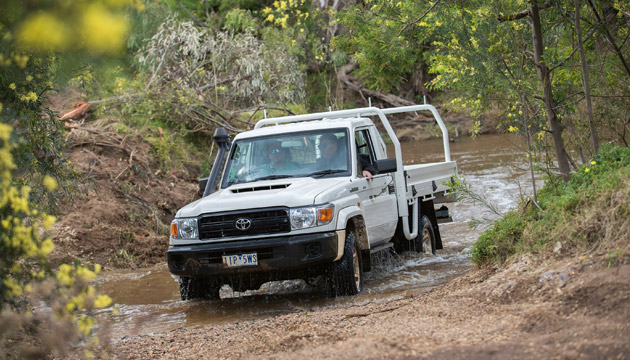The new 70 Series LandCruiser wears its lineage proudly.
Story by Mark Muller
For more than 30 years the Toyota 70 Series has dug itself into the hearts of people wanting a rugged, no-nonsense four-wheel-drive that can take the rough conditions of the Australian outback and keep on going and going … and going. The fact that you see them everywhere in the bush is testament to their reliability and popularity. Once upon a time there were competitors of sorts – the Land Rover Defender and the Nissan Patrol in particular – but 260,000 domestic 70 Series sales later, and it’s the last one standing. And it’s standing strong.
The new 2016 70 Series LandCruiser wears its lineage proudly. You don’t have to squint at it very hard to see 1985 sitting there. Nevertheless, the major investment required by Toyota to earn the single cab chassis version 5-star ANCAP safety (thereby getting it back through the gates of mines around Australia) is clear evidence that the 70 Series will be around for a long time to come. It is still utilitarian and relatively spartan in its base form. And that’s something to love.
The dual-cab, wagon and troopie variants also receive major upgrades, but don’t have all the fruit required to hit the 5-star ANCAP rating. While Toyota was coy about this at the model launch, it’s hard to believe that all the research, time and money spent on getting the single-cab there won’t be offset across the entire range eventually. The Japanese giant undertook more than 100,000 kilometres of local testing while developing this new model. Toyota Australia’s manager of off-road evaluation Ray Munday says that testing in Australia has considerable relevance across the globe. “We have about 80–90% of world conditions here as far as vehicle testing environments go,” he says. The only things missing are extreme cold and extreme altitude. “Basically, we’ve got places in Australia with Third-World conditions, but First-World compliance protocols.”
All models are powered by the feted V8 turbo diesel delivering 151kW of power at 3400rpm, and 430Nm of tourque at 1200–3200rpm. The engine is Euro 5-compliant and returns a claimed fuel economy of 10.7 litres/100km. Taller manual gearbox ratios in second and fifth gears aid this economy. The new model gets upgraded safety electronics including vehicle stability control, active traction control, hill-start assist control, brake assist and electronic brake-force distribution. In addition there is standard cruise control, new fuel injectors and a new diesel particulate filter that regenerates automatically above a certain speed (plus a manual switch).
Toyota has dispensed with the 5.5-inch split rim and tubed tyre and introduced six-inch steel single-piece rim plus tubeless tyres with auto-locking front hubs (with a manual ‘lock’ option). There are also front seatbelt pre-tensioners, front-passenger seatbelt warning, and new steel and alloy tray options.
The single-cab variants have gone further to achieve the 5-star ANCAP safety rating. They have a thicker, stronger, more rigid frame, improved safety, handling and stability, reduced NVH, and three additional airbags in the form of two curtain shields and a driver’s knee bag to bring the total in-cabin to five. There is also under-dash padding for the front-seat passenger, new seats, new body panels and a single 130-litre fuel tank.
You still have to pay an extra $2761 to get air-conditioning. Toyota says that’s because it’s a dealer-fitted option, but really, it’s 2016. Also, Toyota is yet to redress the wheel track difference from front to rear that has drawn criticism in the past. The front axle was made wider to accommodate the V8 diesel back in 2007, and wider it remains. While there’s only roughly 10 centimetres in it, it’s enough to give some people trouble with a wagging tail when tracking through soft sand, for example. There’s good money in meeting an after-market demand for widened rear axles – a demand that should be met in the factory.
That said, this is a pearler of a vehicle that ensures the future of the 70 series for years to come. It drives well, will go just about anywhere, is built like a tank and has the vast Toyota network behind it. And so there’s no real reason for the bush’s love affair with this bus to wain. Another 30 years? Time will tell.
2016 LandCruiser 70 from $60,990
This story excerpt is from Issue #110
Outback Magazine: Dec/Jan 2017










